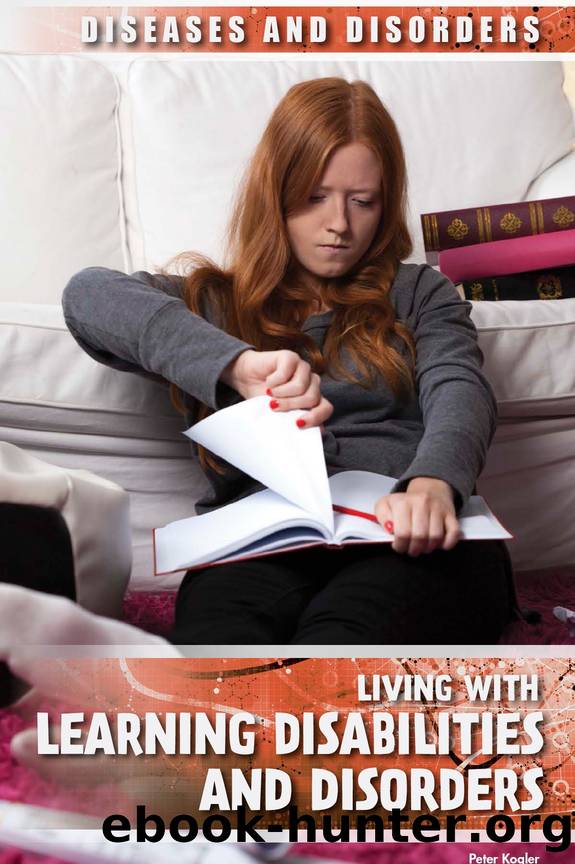Living with Learning Disabilities and Disorders by Kogler Peter;

Author:Kogler, Peter; [Kogler, Peter]
Language: eng
Format: epub
Publisher: Greenhaven Publishing LLC
Published: 2019-09-19T00:00:00+00:00
The Fight Continues
Disability rights movements have a long history, with some activist movements dating back to the 1800s. In the 1930s and 1940s, President Franklin D. Roosevelt, who was paralyzed from the waist down, worked to improve disability rightsâbut in those years, people believed disabilities should be hidden from the public eye. In fact, Roosevelt himself tried as hard as he could never to be photographed in his wheelchair. Smaller movements continued in America until the 1960s, when the major framework for disability rights caught the public eye and spurred more widespread changes. Inspired by the civil rights and womenâs liberation movements, disability rights groups formed across the nation to help create new policies, laws, and special education. The movement started with efforts to protect the rights of the intellectually disabled but quickly spread to those with a wide range of disabilities, from cerebral palsy to hearing impairment.
People with learning disabilities joined the larger movement for disability rights in 1963, when a group of concerned parents whose children struggled to read called a meeting in Chicago. The parents argued that their children had nothing wrong intellectually; furthermore, they knew that the labels placed on their children were damaging to their childrenâs selfesteem. Samuel Kirk attended the meeting and delivered the speech in which he introduced the parents to the term âlearning disability.â According to the Anti-Defamation League, âParent advocates were at the forefront, demanding that their children be taken out of institutions and asylums, and placed into schools where their children could have the opportunity to engage in society just like children who were not disabled.â27
Educators slowly began to respond to the parentsâ demands. In schools across the country, special education services started to expand. In some districts, schools began to âmainstreamâ students with mild to moderate learning disabilities into general education classrooms for a greater portion of the school day, while also offering them support in special education resource rooms. Despite this progress, schools at this time were still under no legal obligation to provide services for students with learning disabilities, and the quality of special education programs differed across America. In the 1970s, courts found exclusion of disabled children in schools to be unconstitutional. Today, students are offered many more rights and opportunities thanks to better laws and policies.
Download
This site does not store any files on its server. We only index and link to content provided by other sites. Please contact the content providers to delete copyright contents if any and email us, we'll remove relevant links or contents immediately.
Teens Talk Tough Times by Jack Canfield & Mark Victor Hansen & Amy Newmark(749)
This Book is Gay by Juno Dawson(495)
Welcome to Sex (Welcome To You Series) by Melissa Kang & Yumi Stynes(363)
What's the T?: The Guide to All Things Trans Andor Nonbinary by Juno Dawson(207)
The DBT Skills Workbook For Teens - Understand Your Emotions and Manage Anxiety, Anger, and Other Negativity To Balance Your Life For The Better by Bucket The Mentor(178)
Accountable by Dashka Slater(178)
Always Smile by Alice Kuipers(170)
The World Between Us by Sarah Ann Juckes(146)
No Way, They Were Gay? by Lee Wind(145)
Human Trafficking by Lita Sorensen(133)
Choosing to Live, Choosing to Die by Tate Nikki;Wuthrich Belle;(133)
Racism in America by Meghan Green(132)
The Fight for Disability Rights by Lisa A. Crayton(130)
The Gay Liberation Movement by Sean Heather K. McGraw(129)
The PTSD Survival Guide for Teens by Sheela Raja & Jaya Ashrafi(127)
Sex: A Book for Teens by Nikol Hasler(126)
Autism Playbook for Teens by Carol Moog(124)
Inspired to Action by Jean Rawitt(119)
Race Relations by Barbara Diggs(119)
